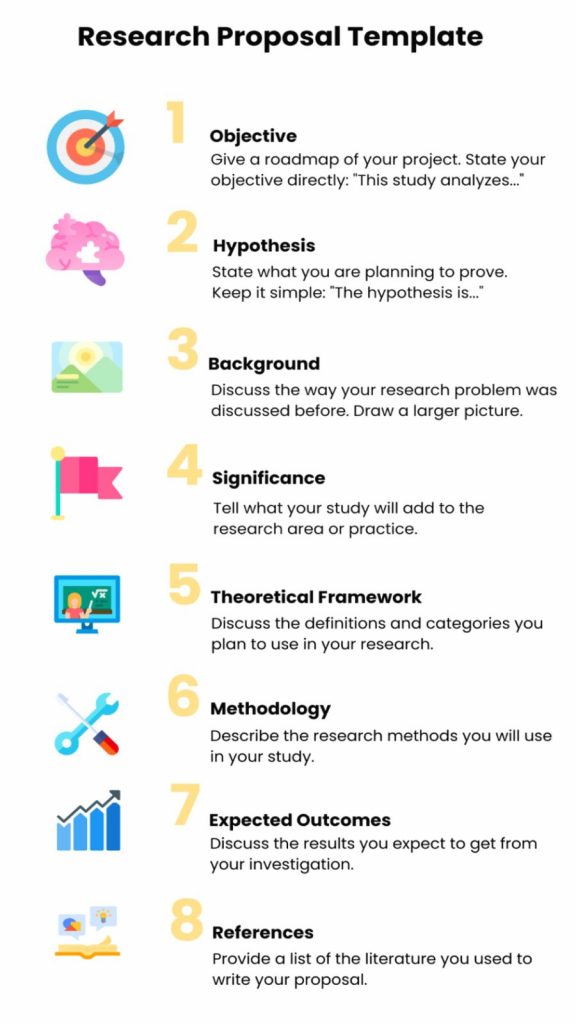To make a research proposal, you need to clearly state your research question, outline your objectives, review relevant literature, and describe your suggested methodology. But what exactly is a research proposal? It’s a paper that aims to show the significance of a particular study.
It is common to do research proposal writing to acquire funding for various research projects. But that’s not all. Perhaps the most essential function of a research proposal is that it provides structure and direction for your entire work. In other words, a proposal isn’t just paperwork—it’s your roadmap and your pitch.
In this guide by our Custom-Writing.org experts, you’ll read how to write a proposal for research, get a customizable template, explore a useful sample you can learn from, and discover common pitfalls to avoid. Ready to follow the steps to write a research proposal effectively? Let’s start!
🤔 Research Proposal: How to Start?
Crafting a strong proposal begins with selecting the right research proposal topic. While this step may seem straightforward, it’s not as simple, as you should choose the one that is relevant and, at the same time, genuinely interests you. Why? Well, practice shows that picking a topic that excites you increases the likelihood of enthusiasm throughout the whole writing process.
If you’re unsure about how to identify a compelling topic, our research proposal writing service can provide expert guidance. Our professionals can help you structure your proposal, refine your draft ideas, create a clear research plan, and ensure your proposal meets academic standards. To start crafting your research proposal, consider the following key questions:
- WHAT topic will you choose? This is a good time to choose a topic or narrow down a topic if it is too broad.
- WHY this topic? Present information on the implications of the topic and present what you intend to achieve.
- HOW will you approach the topic? Indicate the research method you plan to use.
- WHY are you choosing this approach? Provide your justification for selecting this particular method of research.
- WHEN will you finish your research? Provide a timeline for your research, dividing it into smaller, more manageable pieces and setting milestones for each.
- SO WHAT? Explain what your research will add to scientific knowledge.
Be sure to write down the answers to these questions, and then you will be well on your way to writing a spectacular proposal. At this point, you should also spend time reading through your reference material and making notes from all your different sources.
If you need additional guidance, then check out this video that demonstrates how to write a research proposal.
📃 Research Proposal Template
The structure of a research proposal differs depending on the requirements to it. However, the following parts should be included into a typical proposal.

- Objective. This is a brief roadmap of your research project. Be direct when stating your objective: “This study analyzes…”
- Hypothesis. State what you will prove and keep it simple: “The hypothesis of this study is…”
- Background. Discuss whether this problem has been addressed by past researchers and whether there are any controversies or gaps in the literature.
- Significance. State why your study is valuable in today’s educational environment.
- Theoretical framework. Discuss the definitions and/or categories you plan to use in your research.
- Methodology. Discuss the research methods you will use and outline who will be the participants in your study.
- Expected outcomes. Discuss the results you expect to get from your investigation.
- References. Provide a list of the literature you used to write your proposal.
In the next section, you’ll find a research proposal example that contains all of these components. Note that in the “References” section of this sample research proposal, APA style is used. You should follow the citation style recommended by your supervisor.
📑 Research Proposal Sample
Below is a research proposal example that is made in accordance with the template above. After the sample, you’ll find several comments on it.
The Effects of Teachers’ Non-verbal Responses on Students’ Outcomes
Example:
Objective
This study analyzes the effects of teachers’ non-verbal responses on students’ outcomes. Specifically, it investigates the relation between teacher’s postures, gestures, facial expressions, eye contact, and humor and compares this to the students’ perceptions of his/her professionalism. First, this project will demonstrate that the students consider teachers’ non-verbal responses as an essential means of communication in the classroom setting. Next, this study will explore the teachers’ attitudes to non-verbal communication. Finally, the study will offer possible solutions that can help teachers utilize non-verbal cues more effectively.
Hypothesis
This study hypothesizes a direct relationship between a teacher’s positive non-verbal cues, such as postures, gestures, facial expressions, eye contact, humor, and motivation.
Background
Subapriya (2009) and Negi (2009) stated that the non-verbal communication of a teacher could be an excellent alternative to more traditional forms of discipline. In contrast, Andrade and Williams (2009) noted that the effect of a teacher’s non-verbal responses on their students’ performance is inconsequential. A gap in the literature exists in terms of identifying students’ views of teacher’s non-verbal cues. This study will try to fill this gap.
Significance
Today’s teaching methods are different from more traditional ways in which students were “passive listeners.” These days, students are required to be active participants in the class. For this reason, the close relationship between teachers and their students and the psychological atmosphere in the classroom both play a critical role in modern education.
Theoretical framework
This study will utilize the classification of non-verbal cues and responses created by Subapriya (2009).
Methodology
It is the intention that this study utilizes the qualitative research method. Questionnaires will be handed out to 50 students and 20 teachers of Seattle High School. Convenience sampling will be the method by which participants will be chosen because it is the most cost-effective method for this type of research.
Expected outcomes
This study will assess the significance of non-verbal cues as a constituent of teaching strategies. The expected outcome is a set of useful solutions that will help teachers make the best use of non-verbal cues as a component of their teaching strategies.
References
Andrade, M., & Williams, K. (2009). Foreign Language Learning Anxiety in Japanese EFL University Classes: Physical, emotional, expressive and verbal reactions. Sophia, Junior College Faculty Journal, 29, 1 – 24.
Negi, J. (2009). The Role of Teachers’ Non-verbal Communication in ELT Classroom. Journal of NELTA, 14 (1), 101 – 110.
Subapriya, K. (2009). The Importance of Non-verbal Cues. The Icfai University Journal of Soft Skills, 3 (2), 37 – 42.
What makes this a good research proposal example? Here are five reasons:
- It includes only specific and relevant information.
- It discusses only the most critical aspects of the proposed investigation.
- It provides arguments for the use of certain methods.
- It is well-structured.
- It uses simple and direct language.
After reading and analyzing this research proposal sample, you have a much better understanding of how to write your own one. You will also find excellent research proposal examples on the website of the University of Queensland. And you can learn about the importance of a research proposal from our article.
If you have any questions on how to make a research proposal in MLA or APA formats, feel free to use our guides.
❗ Research Proposal Mistakes to Avoid
There are a number of common pitfalls you need to avoid when writing a research proposal. In order to avoid them, take a look at this list of mistakes and the correct approach for each:
Mistakes in Understanding
❌ Wrong: Paper goal = Paper objectives
✔️ Correct: Objectives are smaller parts of the primary goal.
❌ Wrong: Paper subject = Paper object
✔️ Correct: The subject is the broad focus of a research paper and the object is the narrow focus or issue of the research.
❌ Wrong: Thesis statement (TS) = Hypothesis (H)
✔️ Correct: The TS is your argument and the hypothesis is a potential solution you present in the paper.
❌ Wrong: The facts = The major paper argument
✔️ Correct: Your argument is solidified by comparing and contrasting the facts.
Grammatical Mistakes
❌ Wrong: Poor paraphrasing
✔️ Correct: Use synonyms to paraphrase well.
❌ Wrong: Wrong or incorrect format
✔️ Correct: Pay attention to the details of the format and strictly follow the requirements.
❌ Wrong: Lack of connection between sentences
✔️ Correct: Use conjunctions, such as however, nevertheless, moreover, and since.
❌ Wrong: Avoiding the1st person singular
✔️ Correct: Use “I” when it’s reasonable to do so.
🔗 References
- Research Proposal Guide For Hdr Candidates
- Example Student Research Proposals
- How To Write A Good Postgraduate Research Proposal
- Guidelines on writing a research proposal
- Examples of Research proposals
- How to write your research proposal
- Top tips for writing your research proposal
- Ten tips for writing your research proposal
- How to write a great research proposal



![Ultimate Report Writing Tips for Students: Best Ideas [Free]](https://custom-writing.org/blog/wp-content/uploads/2021/01/business-desk-with-keyboard-report-graph-284x153.jpg)





![Library Research Paper: Example & Writing Guide [2025]](https://custom-writing.org/blog/wp-content/uploads/2021/01/library-with-books-284x122.jpeg)
![Research Analysis Paper: How to Analyze a Research Article [2025]](https://custom-writing.org/blog/wp-content/uploads/2021/01/opened-book-library-table-284x153.jpg)

Thank you so much! Even I’m just a junior high student I still need to do an research so thanks to your help
My name is Mmoni in South Africa. Ooh wow what a resource pack wish could have accessed this classical tool last year. Great work of great minds .
Thank you
Excellent! This is what I needed. Thank you.
I agree that starting your research paper or project proposal is one of the most challenging pieces of the process. I’ve found that if you can determine your general topic, you can articulate “what” it is that makes it of interest to you, and potentially others. From that point, you can create an interesting working title and build out an outline for your research, which will include your problem statement, purpose statement, and thesis statement.
If you check out “Practical Research, first steps” in Udemy, you’ll find a course that walks you through this process step by step in less time than it would take to read a textbook on the topic!
Thanks for this excellent information!
Oh, my goodness, Julia. You have no idea how much you helped me with my research proposal. The examples and things to look out for are greatly appreciated. You rock.
Definitely believe the idea that you stated. Your favorite reason appeared to be on the web the easiest thing to be aware of. I definitely get annoyed while people consider worries that they just don’t know anything about. You managed to hit the nail upon the top as well as defined out the whole thing without having a side effect, and people can take a signal. Will likely be back to get more. Thanks|
Great post I hope you continue to post great articles about stress. I am looking for home anxiety remedies. Do you know of anywhere to get some unbiased reviews of these? Again, thank you for this useful post.
Hey! Thanks for the feedback! Unfortunately, I’m not aware of where to find objective reviews, but I can tell you what helps me: a warm bath and a cup of green tea. Here are my remedies 🙂 Hope you will find needed resources and good luck on writing essays! If you need help, you can always contact us.